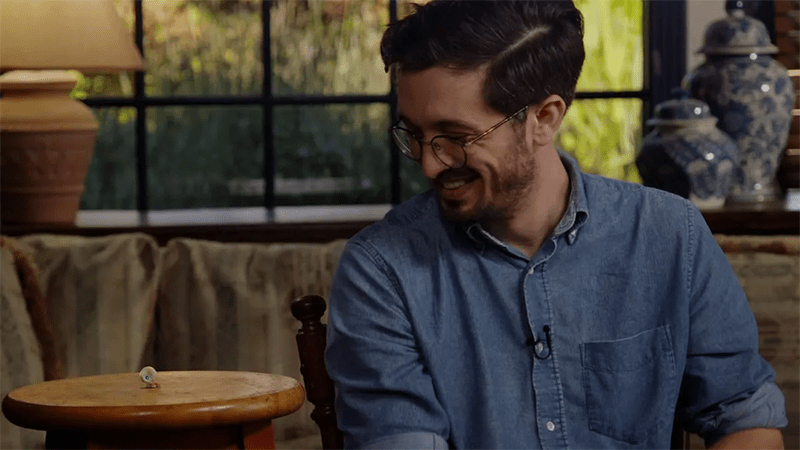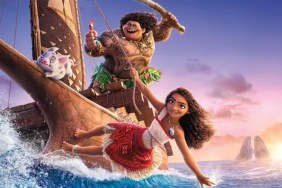ComingSoon spoke with Marcel the Shell With Shoes On director Dean Fleischer Camp to discuss the adorable mockumentary comedy and its origins as a short. The film is currently playing in theaters in the United States.
“Marcel is an adorable, 1-inch-tall shell who ekes out a colorful existence with his grandmother, Connie, and their pet lint, Alan,” reads the film’s synopsis. “Once part of a sprawling community of shells, they now live alone as the sole survivors of a mysterious tragedy. However, when a documentary filmmaker discovers them, the short film he posts online brings Marcel millions of passionate fans, as well as unprecedented dangers and a new hope of finding his long-lost family.”
RELATED: Marcel the Shell with Shoes On Review: An Adorable Adventure
Jonathan Sim: Marcel is such an adorable character that’s been around for so many years. How did you and Jenny Slate originally come up with this interesting original idea of a talking shell?
Dean Fleischer Camp: Originally, it came from us messing around as I’m sure you probably can assume, but the voice came first. We were actually sharing — this is back in 2010 — a hotel room for a friend’s wedding with like nine other people to try to save money. And Jenny felt very cramped and started doing this tiny voice just to express how smushed she felt, and we were like laughing about it. And then when we got back to New York, I had forgotten that I agreed to make a video for my friend’s standup show, which was the following day. So I quickly was like, “Jenny, can I interview you in that voice? I’m going to make a character around it.” And then we ran out to a craft store and bought a bunch of supplies and animated and screened the short that became the first Marcel short for an audience, all within 48 hours.
And then I only put it online because … 2010, back then it wasn’t that common to post or I hadn’t been in the habit of posting everything online. I only put it online because a woman at that show asked if she could send it to her grandmother who was on bed rest and thought it would cheer her up. So that’s why I put it on YouTube.
It’s really amazing how once that happened, it took on this whole life of its own. It started out as a short film series, and now that it’s a feature, I wanted to ask, what was the writing process like to stretch that very simple concept into a 90-minute feature?
We really wanted to … I think everyone these days is so sick of projects that should be feature-length or something, but have been stretched into a 10-episode series. So we really wanted to not make a movie until we were sure it deserved it and not make a movie until we had kind of built his world out and his background and story such that it deserved this bigger telling. The writing process, after we had landed on what the story would be, was that Nick Paley, my co-writer, and I would write for a few months, and then we would record with Jenny, and then, later, the rest of the cast for two or three days. Then we would go back into writing mode for two or three months and we take all the stuff that we’d recorded and that recording with Jenny … she’s such a good improviser. She’d give us all this great stuff and we could pull out the gems and fold that into our screenplay and so we did that over and over again, that cycle, for almost three years.
And at the end of it, we had this great screenplay that both tells this longer, very beautiful story and has big emotional moments, but also has those spontaneous sounding documentary aesthetic dialogue, basically.
I was surprised by how well it ended up paying off ,because stop motion is such a unique animation style and it fits the vibe of this character so well. So I wanted to ask, what was that process like and how long did it ultimately take to make this feature film?
The film took seven years, front to back, which sounds like a lot, but I think those first three years are basically writing the screenplay. So I think probably if you folded the amount of time a movie takes to write into the amount of time it’s been in production, probably most movies would seem that long. But I would say from just the live action production to animation through post, it was I think four years. I agree with you that like stop motion animation has this incredible emotionality to it because it is imperfect. It’s literally animators moving this little sculpture one frame at a time, and therefore you end up with little globs of paint or glue or whatever … you see the actual thumbprints. And I think that because it’s sort of fallible in that way, it’s such an emotional art form.
Tell me about the cinematography in this film. What was the vibe that you wanted to capture while you were working with cinematographer, Bianca Cline?
That’s a really great question. People haven’t asked me that much about the cinematography. To me, it was really important that we maintain the doc authenticity of the shorts, but also of a story that really hinges on us, the audience, investing in this like little absurd character. And then also hinge on the sort of buddy comedy dynamic of Marcel and my character, Dean, that I play. So we really wanted the documentary, the filmmaking, to be expressive in that way. We wanted to feel the presence, a little bit of the filmmaker in the cinematography. It was about finding beauty in small things. So we were constantly trying to figure out, how do we shoot?
“How do we shoot the thing sort of from Marcel’s perspective without actually doing the like full on Honey, I Shrunk the Kids shrinking the camera itself?” So we were often trying to figure out, how do we highlight the things that are beautiful about a dusty corner of an old house? Creatively, [that was] what my conversations with Bianca were centered around. And then also, how do we keep it looking naturalistic while still lighting it? Because sometimes with stop motion, you obviously can’t shoot a shot that’s stop motion over the course of like … it would take many hours, and by that time, the sun would’ve set. So sometimes we’re controlling quote unquote naturalistic sunlight in order to achieve that effect.
But that is only actually half the story, because then there’s a separate stop motion shoot. So Marcel and all of his friends and family are all real stop motion. That’s all done after we shot the live action stuff. We then shoot the animated performances. And the trick with that, or the real challenge, is that those animated performances have to be lit exactly like the shot was shot, that they’re gonna be comped into. So our stop motion DP, Eric Adkins, was on set every day, taking the most intricate notes about where’s the sunlight, what time of day is it, is Marcel standing inches away from like a Coke can, that might reflect light onto him, so that he could recreate it perfectly on the stop motion stages. And it gets even more complicated when you realize that Marcel’s interacting with objects from the live action shoot.
So for example, when he’s in the car and there’s trees passing by and there’s flickers of shadow on Marcel, every time we pass a tree, that means that Eric had to look at the footage and say, “okay, we passed a tree at exactly this time code.” And then he has to automate a flag or like a black thing to pass by the light frame by frame, inch by inch. So that when the animators are animating, that shadow passes over Marcel’s head at the exact moment that we pass by the tree.
Marcel is this character with very adorable quotes. Is there a certain line that Marcel says a certain quote that sticks out to you as your favorite one?
You know, I think my favorite … he has so many great lines and many of them, I quote in my daily life all the time. I think one of my favorite lines from the film actually, isn’t a Marcel quote, but is a quote from Nana Connie, played by Isabella Rossellini, where Marcel says, “I’m afraid, what if everything changes again?” And she says with like this delightful sort of smile, “it will.” And it’s this pivotal moment where she urges Marcel to spread his wings and take a risk. And I just think it’s such a beautiful moment of very efficient screenwriting really on, in this case, Nick Paley’s part. And it says so much in just two words. And I think it’s so beautiful.
What would you like to do next in your career? And is there anything that you’re working on or any particular genre that you wanna work in?
Oh, wow. That’s great too. I mean, it’s so fun to think about these things now. I’ve been working on this film for so long that I’m kind of just catching up to the fact that it’s actually done, but I love working in forms that haven’t been explored really thoroughly before. So this was a project that partly appealed to me because of that stop motion/live action integration. I think there’s so much to be done now. I feel like we’re right on the brink of a real Renaissance in stop motion animation, because it’s such an old art form, but the ways that CG can either can supplement it or can make it easier to do are just about to really pop off in really incredible ways.
If anyone out there’s interested in it, this Netflix short called Robin Robin that a friend of mine made is just so beautiful and does such a great job of integrating CG effects or being able to layer stop motion in a beautiful way. I’m certainly interested in features and television, but I’m really interested in characters like Marcel that are sort of dismissively cute, or maybe dismissively funny, but then are sort of an emotional sneak attack. Because I basically make movies to try to trick my dad into crying in public. So anything that is a good opportunity for that, I’m into.










